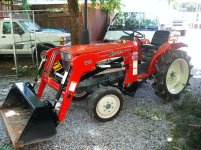You cannot determine the real condition of your engine without a detail look-see. My 1300D I bought a few months ago began belch white smoke. I took compression ($30 Harbor Freight diesel gauge kit) and it read 400 and 425. Should have been more than 500 psi. Rule of thumb take compression ratio (23 to 1 in my engine) multiply that (23) by 2 and take that product (46) and multiply by 14.5. Answer is approx max compression of excellent engine at sea level.
I removed the head and saw that someone had been in the engine (scrape marks where they pried the head off before. Found out that the engine had new cylinder liners (in almost diameter new specs) new after market pistons and bearings. Problem was that rings had too little expansion tension--probably had run hot after overhaul or improper ring seating. Bought two new OEM genuine Yanmar pistons with Yanmar rings(pistons had rings on them from Yanmar) from Jimmy Parker of Parker Equipment and put the engine back together with another new set of bearings. Took the head over to auto machine shop and had valve job done and the head face skimmed, and I replaced the valve seals.
Put it all back together adjusted the valves, bled the fuel system and had it running in 4-5 hours. Runs great. When I have 20 hours or so on it I will check compression, however no white smoke now.
It does not matter if you take all the injectors out to check compression as you are going to turn the engine over with the compression released pulled out any way. I found it was easy to loosen both ejectors hold down nuts a turn or so and let the engine compression loosen the ejectors as I turned the engine over with the stater (leave compression release in). I of course loosened the fuel lines to the ejectors first.
My 1300D shined like a new penny with new paint and tires when I bought it. But that does not mean anything other than what you see is what you have--good paint. What you do not see is what you have also--in my case a less than perfect previous overhaul.
In addition to the above I have replaced the front axle seals, O-rings and king pin bushings, rebuilt the brakes, flushed and replaced all fluids, replaced some rubber hydraulic lines, replaced the battery with a real battery, repaired some of the shade tree electrical wiring, replaced front wheel drive propeller shaft U-joints (this was a real effort-as Yanmar's are not available in 19mm size) and a couple of other small things.
Now the tractor is in reasonable condition and I will replace the rear axle seals next spring. But what the heck, I enjoy doing all this.
I removed the head and saw that someone had been in the engine (scrape marks where they pried the head off before. Found out that the engine had new cylinder liners (in almost diameter new specs) new after market pistons and bearings. Problem was that rings had too little expansion tension--probably had run hot after overhaul or improper ring seating. Bought two new OEM genuine Yanmar pistons with Yanmar rings(pistons had rings on them from Yanmar) from Jimmy Parker of Parker Equipment and put the engine back together with another new set of bearings. Took the head over to auto machine shop and had valve job done and the head face skimmed, and I replaced the valve seals.
Put it all back together adjusted the valves, bled the fuel system and had it running in 4-5 hours. Runs great. When I have 20 hours or so on it I will check compression, however no white smoke now.
It does not matter if you take all the injectors out to check compression as you are going to turn the engine over with the compression released pulled out any way. I found it was easy to loosen both ejectors hold down nuts a turn or so and let the engine compression loosen the ejectors as I turned the engine over with the stater (leave compression release in). I of course loosened the fuel lines to the ejectors first.
My 1300D shined like a new penny with new paint and tires when I bought it. But that does not mean anything other than what you see is what you have--good paint. What you do not see is what you have also--in my case a less than perfect previous overhaul.
In addition to the above I have replaced the front axle seals, O-rings and king pin bushings, rebuilt the brakes, flushed and replaced all fluids, replaced some rubber hydraulic lines, replaced the battery with a real battery, repaired some of the shade tree electrical wiring, replaced front wheel drive propeller shaft U-joints (this was a real effort-as Yanmar's are not available in 19mm size) and a couple of other small things.
Now the tractor is in reasonable condition and I will replace the rear axle seals next spring. But what the heck, I enjoy doing all this.
